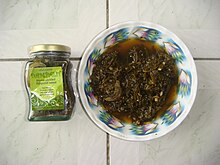

আচারা ( Philippine: আছারা; Spanish: achara), হল কাচা পেঁপের তৈরি এক প্রকার আচার যা ফিলিপাইনে খুবই জনপ্রিয় । [1] এই খাদ্যটি প্রায়শই সহকারী খাদ্য হিসেবে ভাঁজা বা পোড়ানো খাদ্য যেমনঃ শুকরের বারবিকিউ এসবের সাথে পরিবেশন করা হয় । খাবারের নামটি দক্ষিণ ভারতের আচার কিংবা ইন্দোনেশিয়া ও মালোয়শিয়ার আচর নামের সাথে সামঞ্জস্যপূর্ণ ।
প্রস্তুতি
The primary ingredient is grated unripe papaya. Carrot slices, julienned ginger, bell pepper, onion and garlic make up the other vegetables. Raisins or pineapple chunks may be added, and chilies, freshly ground black pepper, red pepper flakes, or whole peppercorns complete the mixture. These are then mixed in a solution of vinegar, sugar/ syrup, and salt preserves.
The mixture is placed in airtight jars where it will keep without refrigeration, however once opened it is preferably kept chilled to maintain its flavour. [2]
Variants

- Atsarang maasim (sour pickles) - is prepared in the same way as normal Atchara except that no sugar is added. [2]
- Atsarang labóng (pickled bamboo shoots) - are prepared in the same way as Atchara, but use bamboo shoots instead of papaya. [3]
- Atsarang dampalit (pickled sea purslane) - made from Sesuvium portulacastrum, called dampalit in Tagalog. [4] [5]
- Atsarang ubod (pickled palm hearts) - made from palm hearts, called ubod in Tagalog. [6]
See also
- Acar in Indonesian and Malaysian cuisine
- Achaar (pickle) in Indian cuisine
- List of fermented foods
- Pickled cucumber
- Pickled onion
- Sauerkraut
- Tsukemono
-
 Food portal
Food portal
References
- ^ Zabilka, G. (2007). Customs and Culture of the Phillippines. Tuttle Publishing. p. pt111. ISBN 978-1-4629-1302-2. Retrieved November 3, 2017.
- ^ a b Dagoon; et al. (1997). Culinary Arts II. Rex Bookstore, Inc. ISBN 978-971-23-2157-3.
- ^ Jesse D. Dagoon (1989). Applied nutrition and food technology. Rex Bookstore, Inc. ISBN 978-971-23-0505-4.
- ^ "Atsarang Dampalit". Provincial Government of Bulacan, Philippines. Retrieved September 23, 2012.
- ^ "Atsarang Dampalit". Market Manila. May 25, 2009. Retrieved September 23, 2012.
- ^ "Ubod / Heart of (Coconut) Palm". Market Manila. February 21, 2008. Retrieved September 23, 2012.


আচারা ( Philippine: আছারা; Spanish: achara), হল কাচা পেঁপের তৈরি এক প্রকার আচার যা ফিলিপাইনে খুবই জনপ্রিয় । [1] এই খাদ্যটি প্রায়শই সহকারী খাদ্য হিসেবে ভাঁজা বা পোড়ানো খাদ্য যেমনঃ শুকরের বারবিকিউ এসবের সাথে পরিবেশন করা হয় । খাবারের নামটি দক্ষিণ ভারতের আচার কিংবা ইন্দোনেশিয়া ও মালোয়শিয়ার আচর নামের সাথে সামঞ্জস্যপূর্ণ ।
প্রস্তুতি
The primary ingredient is grated unripe papaya. Carrot slices, julienned ginger, bell pepper, onion and garlic make up the other vegetables. Raisins or pineapple chunks may be added, and chilies, freshly ground black pepper, red pepper flakes, or whole peppercorns complete the mixture. These are then mixed in a solution of vinegar, sugar/ syrup, and salt preserves.
The mixture is placed in airtight jars where it will keep without refrigeration, however once opened it is preferably kept chilled to maintain its flavour. [2]
Variants

- Atsarang maasim (sour pickles) - is prepared in the same way as normal Atchara except that no sugar is added. [2]
- Atsarang labóng (pickled bamboo shoots) - are prepared in the same way as Atchara, but use bamboo shoots instead of papaya. [3]
- Atsarang dampalit (pickled sea purslane) - made from Sesuvium portulacastrum, called dampalit in Tagalog. [4] [5]
- Atsarang ubod (pickled palm hearts) - made from palm hearts, called ubod in Tagalog. [6]
See also
- Acar in Indonesian and Malaysian cuisine
- Achaar (pickle) in Indian cuisine
- List of fermented foods
- Pickled cucumber
- Pickled onion
- Sauerkraut
- Tsukemono
-
 Food portal
Food portal
References
- ^ Zabilka, G. (2007). Customs and Culture of the Phillippines. Tuttle Publishing. p. pt111. ISBN 978-1-4629-1302-2. Retrieved November 3, 2017.
- ^ a b Dagoon; et al. (1997). Culinary Arts II. Rex Bookstore, Inc. ISBN 978-971-23-2157-3.
- ^ Jesse D. Dagoon (1989). Applied nutrition and food technology. Rex Bookstore, Inc. ISBN 978-971-23-0505-4.
- ^ "Atsarang Dampalit". Provincial Government of Bulacan, Philippines. Retrieved September 23, 2012.
- ^ "Atsarang Dampalit". Market Manila. May 25, 2009. Retrieved September 23, 2012.
- ^ "Ubod / Heart of (Coconut) Palm". Market Manila. February 21, 2008. Retrieved September 23, 2012.
